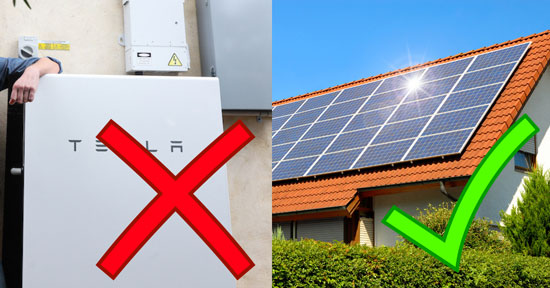The Truth About Buying Solar In California
5 little-known facts that could make or break your investment
By Andrew Sendy, 23 year veteran of the solar industry and owner of Solar Wholesalers.

Truth #1 - Batteries do not pay for themselves
Despite the hype about solar battery storage, any honest solar installer will give you the same advice: Batteries will not pay for themselves in 2019, even in sunny California.
At the moment, a Tesla Powerwall battery system will cost you $7,000 to $8,200 to install and will take 10 years to pay back at best. The unit is warranted to last 10 years.
You do the maths.
A solar panel system will pay for itself in seven years and one month in California, and is warranted for 25 years. You have almost an 18-year margin of safety to get your money back. If the system requires repairs or maintenance you will have saved enough from lower electricity bills to cover these costs. There is no margin for error with a battery.
Unfortunately, all the hype in the mainstream media about batteries has made people question the viability of solar without batteries - to the extent that people are waiting for 'affordable batteries' before they invest in solar.
But even though the cost of solar battery storage is projected to decline year-over-year, it makes no sense to wait to get solar.
Every day you don't have solar is another day you do have to pay high electricity bills. A well designed solar system without batteries can give you tiny bills.
Waiting 2, 3 or 4 years for batteries to become affordable means another 2, 3 or 4 years of high bills.
One day, batteries will make lots of sense - and when that day comes they can easily be added to any existing solar system using a method called AC coupling.
So don't lose years of savings waiting for cheap batteries to arrive.
Consider going solar now - with the knowledge that you can easily retrofit batteries later when they will pay for themselves - not before.
Find out how much solar costs without batteries for your home
Truth #2 - Leasing a system is 43% more expensive than purchasing outright
In most cases, you will save a lot more money over the 25-year life of a solar system by buying a solar system outright rather than leasing it. The exception to this rule is when you do not have the federal tax liability (low-income earners) to maximize the 30% federal solar tax credit.
We ran the numbers on a 5kW solar system. A system purchased with a 5% per annum HELOC loan generated $39,000 in savings, almost $14,000 more than a leased system.
Beyond the financial savings, you also do away with the hassle of assigning the lease if you decide to sell your home before the end of the 20-25 year lease.
With the price of solar declining by 60% in the last several years combined with low-interest rates, the benefits of a solar lease no longer make sense for most Californians.
Find out which is the best way to finance the purchase of solar for you here:
Truth #3 - The 30% Federal solar tax incentive will end in 2021
It gets worse. The investment tax credit (ITC) will fall to 26% in 2020, then 22% in 2021 and then ceasing entirely on 31 December 2021. That means you have less than five months to get the maximum credit possible.
The investment tax credit is a federal tax credit that reduces your tax liability by 30% of the value of your investment in solar. So for a 5kW system costing $18,750, you will receive a credit of $5,625. Using this example, waiting until 2020 will mean you lose out on $750. Waiting until 2021 will cost you an extra $1,500.
There is also the risk that President Trump, who has been outspoken in his support for fossil fuels, moves to repeal the ITC. This is not an idle threat. In January 2018 Trump placed a 30% tariff on imported solar panels. Given that almost all of the less expensive but also dependable panel brands are imported, this effectively increased the cost of a solar system by 11%, once you factor in installation labor and other necessary parts. So the cost of solar has already gone up.
In September Trump announced another tariff, this time on Chinese made solar inverters. On 1 January 2019 this tariff rose to 25%, up from 10%. The tariff will affect the two big inverter brands sold in the US, Enphase, and SolarEdge.
Every day you wait to get solar is another day where Trump could slap another tariff on solar components. The cheapest time to get solar was in January 2018. The next best time is now.
Find out what solar will cost you after incentives, including the latest Trump import tariffs
Truth #4 - Net metering is under real threat from utilities
Net metering is where the amount of energy you buy in from the grid and the amount of excess solar energy you export to the grid are recorded separately and you are only billed for the net of these two numbers.
I believe net metering is the most valuable incentive for solar, even more so than the ITC. Net metering law is what guarantees that you save the full retail value of every kilowatt-hour of electricity that your solar system generates, even if you are not using power when your solar is generating.
The California Public Utility Commission voted by a narrow majority of three to two to extend the ability of residential energy customers in California to be credited with full retail rates for excess solar power that they generate.
It means you can now install solar panels and sign a contract with your utility (known as a net metering agreement) where the utility guarantees to pay you a retail rate for exported solar power, usually for 10 or 15 years.
Each of the major utilities may offer slightly different net metering contracts but they are similar in nature.
Our solar calculator is the only calculator that uses time-of-use (ToU) billing to estimate what your monthly bill will be with solar. You are required to be on ToU plan if you export electricity to the grid. Take advantage of this generous net metering law while it is still available.
Find out how quickly solar will pay for itself using your local utilities rate plan
Truth #5 - The direction of your roof is not critical
Some homeowners think that solar isn’t viable for them because their roof faces east or west. The reality is that east or west-facing panels will only generate 12% less electricity on an annual basis compared to south facing panels. The loss is only around 5% for south-east and south-west facing roofs.
The decline in production can be easily offset by adding additional panels. A 5kW system with a 12% decline in year-round production due to a west or east facing roof can simply add two more 300W panels to the array and the annual production will be similar to a south facing system.
Find out what system size you need to reduce your electricity bill to zero
Start the process by finding out what solar will cost to install on your home, and how quickly it will pay you back with the Solar-Estimate.org calculator. Using cost data from thousands of actual installations in California, including your zip code, we can accurately estimate what solar will cost to install, and the savings over the lifetime of your ideal system.
 Author: Andrew Sendy
Author: Andrew Sendy
As chairman of Solar Investments Inc and chairman of the largest solar panel installation company in South Australia, Andy is passionate about solar power. With his unique working background, he writes on the residential solar industry in America from a unique perspective.
